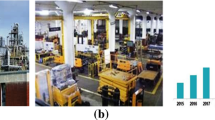Abstract
The Quick Response (QR) code is designed for information storage recognizable by machine vision. With the popularity of QR code applications, the security of QR codes becomes hot issues concerned by many scholars. In this paper, a novel QR code with two-level information storage is designed to protect private messages. In the meantime, the public level can be directly decoded by any standard QR reader. In contrast to other studies, the computational complexity of the proposed scheme is reduced by combining with the theory of visual cryptography scheme (VCS). In addition, an important characteristic of the QR code, error correction capability, is preserved in this paper, guaranteeing the robustness to QR code damage. Experimental results and analysis show that the proposed scheme is both feasible and reasonably secure, further enriching the application fields and outperforming the previous schemes significantly.










Similar content being viewed by others
References
Arumugam S, Lakshmanan R, Nagar AK (2014) On (k, n)*-visual cryptography scheme. Des Codes Crypt 71:153–162. https://doi.org/10.1007/s10623-012-9722-2
Ateniese G, Blundo C, Santis AD, Stinson DR (1996) Visual cryptography for general access structures. Inf Comput 129:86–106. https://doi.org/10.1006/inco.1996.0076
Chen C (2016) QR code authentication with embedded message authentication code. Mob Netw Appl 22:383–394. https://doi.org/10.1007/s11036-016-0772-y
Chow YW, Susilo W, Yang G, Phillips JG, Pranata I, Barmawi AM (2016) Exploiting the error correction mechanism in QR codes for secret sharing. Australasian conference on information security and privacy, pp 409–425. Springer International Publishing. doi:https://doi.org/10.1007/978-3-319-40253-6 _25
Chu HK, Chang CS, Lee RR, Mitra NJ (2013) Halftone QR codes. ACM Trans Graph 32:217. https://doi.org/10.1145/2508363.2508408
Cui J, Liu Y, Xu Y, Zhao H, Zha H (2013) Tracking generic human motion via fusion of low- and high-dimensional approaches. IEEE Trans Syst Man Cybern B 43:996–1002. https://doi.org/10.1109/TSMCA.2012.2223670
ISO, IEC 18004: 2006 (2006) Information technology – Automatic identification and data capture techniques – QR Code 2005 bar code symbology specification, International Organization for Standardization, Geneva, Switzerland
Krishna MB, Dugar A (2016) Product authentication using QR codes: a mobile application to combat counterfeiting. Wirel Pers Commun 90:381–398. https://doi.org/10.1007/s11277-016- 3374-x
Lin PY (2016) Distributed secret sharing approach with cheater prevention based on QR code. IEEE Trans Ind Inf 12:384–392. https://doi.org/10.1109/TII.2015.2514097
Lin PY, Chen YH (2017) High payload secret hiding technology for QR codes. EURASIP J Image Video Process. https://doi.org/10.1186/s13640-016-0155-0
Liu Y, Zhang X, Cui J, Wu C, Aghajan H, Zha H (2010) Visual analysis of child-adult interactive behaviors in video sequences. International conference on virtual systems and multimedia, pp 26–33. IEEE. doi:https://doi.org/10.1109/VSMM.2010.5665969
Liu Y, Fu ZX, Wang YW (2016) Two-level information management scheme based on visual cryptography and QR code. Appl Res Comput 33:3460–3463. https://doi.org/10.3969/j.issn.1001-3695.2016.11.057
Liu Y, Nie L, Han L, Zhang L, Rosenblum DS (2016) Action2activity: recognizing complex activities from sensor data. Proceedings of the twenty-fourth international joint conference on artificial intelligence, pp 1617–1623
Liu Y, Nie L, Liu L, Rosenblum DS (2016) From action to activity: sensor-based activity recognition. Neurocomputing 181:108–115. https://doi.org/10.1016/j.neucom.2015.08.096
Naor M, Shamir A (1995) Visual cryptography. EUROCRYPT 1994. Advances in cryptology — EUROCRYPT'94, vol 950, pp 1–12. doi:https://doi.org/10.1007/BFb0053419
Patvardhan C, Kumar P, Lakshmi CV (2017) Effective Color image watermarking scheme using YCbCr color space and QR code. Multimed Tools Appl. https://doi.org/10.1007/s11042-017-4909-1
Shyu SJ, Chen MC (2015) Minimizing pixel expansion in visual cryptographic scheme for general access structures. IEEE Trans Circuits Syst Video Technol 25:1557–1561. https://doi.org/10.1109/TCSVT.2015.2389372
Tkachenko I, Puech W, Destruel C, Strauss O, Gaudin JM, Guichard C (2016) Two-level QR code for private message sharing and document authentication. IEEE Trans Inf Forensics Secur 11:571–583. https://doi.org/10.1109/TIFS.2015.2506546
Tuyls P, Hollmann HD, Lint JH, Tolhuizen L (2005) XOR-based visual cryptography schemes. Des Codes Crypt 37:169–186. https://doi.org/10.1007/s10623-004-3816-4
Wan S, Lu Y, Yan X, Wang Y, Chang C (2017) Visual secret sharing scheme for (k, n) threshold based on QR code with multiple decryptions. J Real-Time Image Proc. https://doi.org/10.1007/s11554-017-0678-3
Wang J, Song L, Liang X, Liu Y, Liu P (2016) Secure and noise-free nonlinear optical cryptosystem based on phase-truncated Fresnel diffraction and QR code. Opt Quant Electron 48:523. https://doi.org/10.1007/s11082-016-0796-3
Weir J, Yan WQ (2011) Authenticating visual cryptography shares using 2D barcodes. IWDW 2011: Digital Forensics and Watermarking, vol 7128, pp 196–210. doi:10.1007/978–3–642-32205-1_17
Xie X, Livermore C (2016) A pivot-hinged, multilayer SU-8 micro motion amplifier assembled by a self-aligned approach. Proc. of International Conference on MICRO Electro Mechanical Systems, In, pp 75–78. https://doi.org/10.1109/MEMSYS.2016.7421561
Xie X, Livermore C (2017) Passively self-aligned assembly of compact barrel hinges for high-performance, out-of-plane mems actuators. In: Proc of international conference on MICRO electro mechanical systems doi:https://doi.org/10.1109/MEMSYS.2017.7863532
Xie X, Zaitsev Y, Velasquezgarcía LF, Teller SJ, Livermore C (2014) Compact, scalable, high-resolution, MEMS-enabled tactile displays. In: Proc. of solid-state sensors, actuators, and microsystems workshop, pp 127–30
Xie X, Zaitsev Y, Velasquezgarcía LF, Teller SJ, Livermore C (2014) Scalable, MEMS-enabled, vibrational tactile actuators for high resolution tactile displays. J Micromech Microeng 24:125014. https://doi.org/10.1088/0960–1317/24/12/125014
Yang CN, Liao JK, Wu FH, Yamaguchi Y (2016) Developing visual cryptography for authentication on smartphones. doi:https://doi.org/10.1007/978-3-319-44350-8_19
Yang CN, Wu CH, Yeh ZX, Wang DS, Kim C (2017) A new sharing digital image scheme with clearer shadow images. Comput Stand Interfaces 51:118–131. https://doi.org/10.1016/j.cs i.2016.11.015
Acknowledgements
The authors thank the anonymous reviewers for their valuable comments. This work was supported in part by the National Natural Science Foundation of China under Grant No.61602513 and the Outstanding Youth Foundation of Zhengzhou Information Science and Technology Institute under Grant No.2016611303.
Author information
Authors and Affiliations
Corresponding author
Rights and permissions
About this article
Cite this article
Cheng, Y., Fu, Z., Yu, B. et al. A new two-level QR code with visual cryptography scheme. Multimed Tools Appl 77, 20629–20649 (2018). https://doi.org/10.1007/s11042-017-5465-4
Received:
Revised:
Accepted:
Published:
Issue Date:
DOI: https://doi.org/10.1007/s11042-017-5465-4




